#pere ubu
Explore tagged Tumblr posts
Note
hello big man. i have seen the many music asks and i raise you one of my own: have you listened to johnny manchild and the poor bastards? would you care to? also you should throw a music rec at me. i've seen u post about devo quite a bit recently and i do enjoy them so if you have anything of a similar veinnnn... :3c
we just lost one if the greatest frontmen of all time: David Thomas from the band Pere Ubu. They debuted around the same time and place as Devo (Pere Ubu from Cleveland, Devo from Akron) so check out Pere Ubu
youtube
91 notes
·
View notes
Text


Paul Morley reviews Throbbing Gristle, Cabaret Voltaire, The Normal.
Plus a flyer for the gig.
Also that Pere Ubu, Red Crayola gig looks rad as hell.
#throbbing gristle#cabaret voltaire#metabolist#the normal#robert rental#pere ubu#red crayola#noise#industrial#experimental#post-punk
87 notes
·
View notes
Text

RIP David Thomas
June 14, 1953 – April 23, 2025
63 notes
·
View notes
Text

Rocket From The Tombs - WMMS 101 FM, Cleveland, Ohio, February 23, 1975
Goodbye to David Thomas — AKA Crocus Behemoth — co-founder and longtime leader of Pere Ubu, that bewitching hive of Cleveland strangeness. Like Captain Beefheart or Mark E. Smith, he was a powerful catalyst, able to forge a singular vision out of wildly disparate elements (and wildly different lineups). A real character, the likes of which we probably won't see again.
David Says: We live in a world where everyone is afraid. The Emperor has no clothes but never dare to whisper it or you invite a heap of abuse and character assassination. So we do what folk musicians have done in similar circumstances for thousands of years. We encode the truth in tradition and a secret language that only others of our kind will understand. We make a pact with the geography we inhabit and together we speak of things seen through the cracks and seams of the world of humanity.
In Thomas' honor, let's go back to somewhere near the beginning — a WMMS broadcast of a Rocket From The Tombs rehearsal in early 1975. Some of this tape showed up on the essential The Day The Earth Met Rocket From The Tombs compilation, but it's very much worth hearing in its unedited form, with Peter Laughner's narrative asides included. Lurching from Stooges blowouts to Alice Cooper-style creeps to truly original masterpieces (the always astonishing "30 Seconds Over Tokyo"), RFTT blazes throughout, Thomas howling and hissing his way forward.
The band blazed a little too bright for their own good, of course, soon splintering into the Dead Boys and the first lineup of Pere Ubu. And hey, speaking of those early Ubu days, the vital Palmer Eldritch YouTube channel just shared a heretofore unheard recording of the band in early '76 ... allegedly playing a high school dance of some kind?! And what does the band play for the kids? That old La Cave anthem — the VU's "Heroin."
30 notes
·
View notes
Text
RIP David Thomas
not the wendys guy, not the kid in the hall
youtube
i heard pere ubu's the modern dance as a teenager but what made me a "fan" was actually encountering some of thomas's critical writing, the liner notes to later album raygun suitcase which were quoted by greil marcus in a new foreward to his book mystery train, on elvis fans and the appeal of lives you'll never get to live. i wanted to know how they got there and what they did next.
something i always admired about both pere ubu and about thomas's solo work is the sense that failure, perversity and spite were always built into the project. the original version of pere ubu formed as a way to release a record as a weird artifact people would find in charity bins and be startled by, not know how to parse, and there's a sense the rest of their work is playing on the same feeling - inventing the career of an imaginary band, one which would unfold in mounting strangeness. One where the experimental cubist period would precede a peppy, paranoid 80s new wave pop period would precede grinding hard rock would precede odd studio collage, with digressions to soundtrack old scifi movies and put on an Ubu Roi musical. i think you get some sense of it from this tv performance - notice how he draws out the opening bit, sees it's playing too well with the crowd, abruptly switches gears, keeps going and making it more tangled until the laughter becomes nervous - and THEN starts the song.
some of my favourite pere ubu albums are the later ones like "lady from shanghai", part of a period where all the members would record parts seperately and have thomas stitch them together into new songs in studio to create odd, rickety take on "dance music". but i think my favourite records he did were the recordings with 2 pale boys. "surf's up" is my favourite album by them but the track "prepare for the end" is i think my favourite distillation of the line he was always walking between the goofy and the terrifyingly intense.
youtube
“We did the first record not as a beginning, but as an ending,” Thomas said in 1993, in likely the most interesting words ever written for a record industry press release, in this case for the then-new Pere Ubu album Story of My Life. “We wanted to leave an artifact that someone would discover. We were done—we were about to move on to real life.” But it didn’t work out that way, he said: “We had the misfortune to have a dream and vision at an early age that was too powerful to shake in older life. If you’re young enough and if the vision is strong enough, you will never lose it—like the people who became Communists in the ’30s. They had no alternative but to continue…We saw what rock music should be and could be nothing less than that would ever do for us.”
stand by earth man
youtube
45 notes
·
View notes
Text

R.I.P. David Thomas, aka Crocus Behemoth (Pere Ubu, Rocket from the Tombs, more...)
Where to start with this latest reminder of mortality...
David Thomas was the first ostensibly rock'n'roll voice I heard that really convinced me you can sound however the fuck you want to sound.
In 1986, I'd found Pere Ubu's debut LP, The Modern Dance (on the original Blank label, no less) sealed in a sale bin at the mall record store for 99 cents! (Also nabbed a sealed first Saints LP too. That was a good day. Also proof that our suburb had no taste. Apparently the store was clearing out a back room.)
youtube
Anyway, I'd already heard a bit of Pere Ubu, growing up in their hometown of Cleveland and all (albeit I was a tot during their birth). But hearing that whole album made me think about the bends R'n'R could take as much as seeing 2001: A Space Odyssey alone in a theater at age 12 made me rethink movies.
Ultimately discovering the pre-Pere Ubu, protopunk lynchpin, Rocket from the Tombs (that's David in the middle of the five up there) cemented not only Thomas' place in my musical heart, but the importance of Cleveland as punk ground zero. I've talked about that a lot in this blog, so you know.
Though it's worth adding that Thomas' sartorial sense was a thing to behold in found mag pix in Cleveland when I was a teen -- he seemed to go from Sun Ra acolyte to door-to-door vacuum cleaner salesman, from Beatnik poet to shlubby psych professor.
I first saw Thomas in Pere Ubu when they did the "Avant Garage" reunion tour in 1987, down at Peabody's in Cleveland's Flats even, not a 1/4 mile from where RFTT once practiced. Was a great show, as was a David Thomas & Two Pale Boys set I saw there a couple years later, wherein Thomas often seemed like a stand-up comedian on visit from Pluto -- his sense of humor was always something I thought got short shrift. Even his surliest retorts in interviews or onstage were laced with subsumed smirks.
youtube
Never saw him again until the incredible first RFTT U.S. reunion show in Columbus, OH, at Little Brothers in 2003, and in Cleveland a couple weeks later. Columbus was everything I'd hoped it could be -- older but energized and hearing songs from 4 of the original 5 members I never thought I'd hear. Oddly, the Cleveland show wasn't quite as great though more interesting in its way, as the band seemed a wee nervous with so much family and old friends in the crowd -- especially Thomas. For a man who has a legendary rep as a curmudgeon, it was almost sweet to see him smiling and tipping his hat here and there. Still and all, a great show.
youtube
Looking back, those shows in ways bookended my time as an Ohioan, as I moved to NYC in 2004. I guess I saw and heard all I'd needed to, via two Rocket from the Tombs shows that seemed sent form the punk gods as a boot to my behind. Hell, even David Thomas eventually left Cleveland. That's like one of the old Flats factories getting up and taking a plane to London.
I saw a later iteration of Pere Ubu in Brooklyn circa early 2010s. It was solid and I'm glad I went. David was starting to seem sickly-ish around then, if still mewly menacing.
Until the very end, Thomas' presence was the startling focal point of any stage he trod upon. In the early punk days, lead singers were usually scrawny early 20-somethings jumping around in ripped jeans and a tee. Thomas though appeared as a preternaturally stern, 40-something principal, his searing eyes looking like he was about to banish you to the detention hall -- then eyelids pinching down closed fourfold, a facial expression of "The horror, the horror...." It all flew (or stewed) in the face of any seeming "punk template" that might've still been being developed into the 1980s, so that even by the time I finally saw him live, he seemed light years into the future of what the hell a "lead singer" might evolve into 40 years hence.
An event I remember pretty well was a really cool, free talk between David and rock historian Greil Marcus at a New School classroom on some random Wednesday night in 2009. The small crowd sat in desks while David and Marcus sat at the teacher's table and pontificated over hidden history, Ubu projects, Cleveland, the end of Industrial Age America, and even a few laughs.
I only met and tried to talk to David Thomas a few times over the years, and he was cordial enough and strange, as desired. He always struck me as the kind of person who assumes most people are, shall we say, intellectually lazy; and when he is sidled up next to one who isn't, like Marcus, he loosens up. That was a great night, pre-cellphone for me, no pix, just mind images...
I recall Thomas announced in some interview around the early 1990s, I believe, that there are too many bands, people should stop forming bands. Once Pere Ubu really ratcheted up again in the 2000s, sprouting around in different years and different iterations until his death, the whole thing turned into a project, constantly posting live shows, reissuing records, recording new ones, new RFTT albums even. So while technically he wasn't forming new bands, he sure was Dr. Frankensteining the hell out of 'em.
Of course now I'm bummed I skipped the last time Pere Ubu came to NYC, about a year ago. Though I heard from a friend who saw them a few times as far back as 1978 that it wasn't that good, as Thomas basically sat and complained the whole time -- which in and of itself might have been another intriguing experience from the man who started his career as a dive bar bouncer while writing for Scene Magazine in Cleveland, under the name of Crocus Behemoth. That I started my meager attempts at art-spew at Scene Magazine I uneasily take as some kind of connection.
youtube
What I soaked up from David Thomas' artistic endeavors was admittedly mostly from his era of living and working in Cleveland and NYC. Though I love the 1989 Pere Ubu album, Cloudland, as much as any, by that time, David was an ex-pat, and understandably so. America was never going to give a guy like that the barrel of back slaps he deserved. Not that he cared.
That knowing slant and dank noise was David Thomas' legacy for so many fans around the world, possibly most absorbed by his Northeast Ohio fans -- summed up perfectly for me by this interview quote from a Guardian article:
"Everything from Cleveland was doomed. Rocket from the Tombs is totally inconsequential and irrelevant. That is the power of Cleveland. Embrace, my brothers, the utter futility of ambition and desire.”
R.I.P. David Thomas, and thanks.
-----------------------------------------
Pere Ubu (Official) Facebook obit
Cleveland.com obit
youtube
Check out this good interview from 2006, on the Bored Out blog.

From early Pere Ubu days; not sure of the photographer; if you know, please let me know so I can credit.
#pere ubu#david thomas#rocket from the tombs#cleveland punk#protopunk#Industrial Age#ClePunk#Cleveland history#punk history#Youtube
22 notes
·
View notes
Text
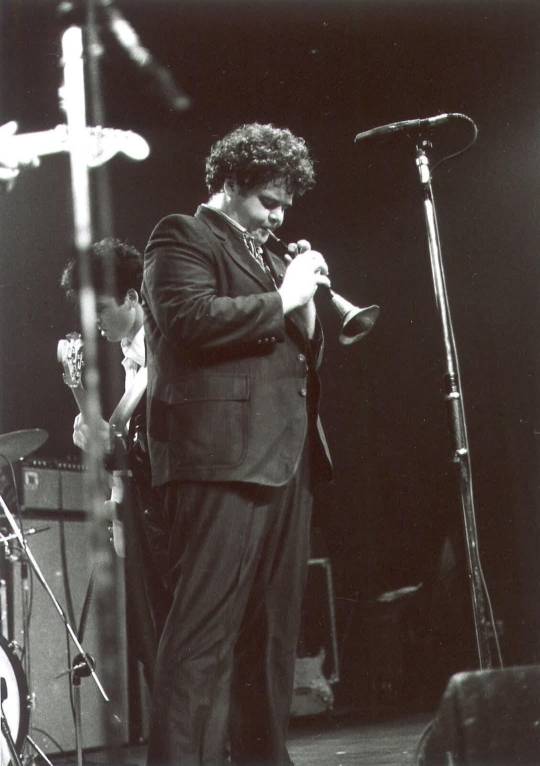
David Thomas (R.I.P.)
21 notes
·
View notes
Photo
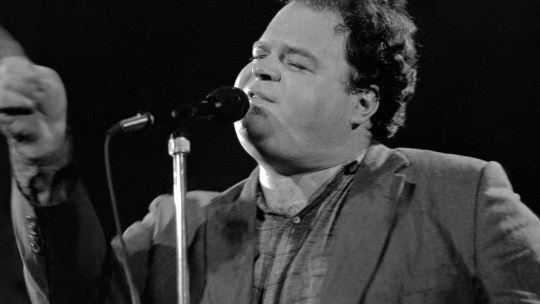
(via David Thomas, Pere Ubu Singer, Dead at 71)
David Thomas, lead singer of the avant-garage band Pere Ubu and the Cleveland proto-punk group Rocket From the Tombs, has died at the age of 71.
21 notes
·
View notes
Text
Farewell, David Thomas.
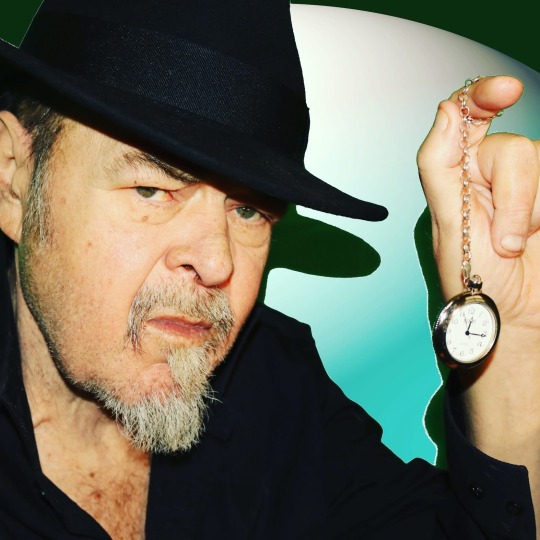
From the Pere Ubu Facebook page:
David Thomas, June 14 1953 - April 23 2025.
David Lynn Thomas, lead singer of Pere Ubu, Rocket From The Tombs and multiple solo projex, has died after a long illness.
On Wednesday, April 23 2025, he died in his home town of Brighton & Hove, with his wife and youngest step-daughter by his side. MC5 were playing on the radio. He will ultimately be returned to his home, the farm in Pennsylvania, where he insisted he was to be “thrown in the barn.”
David Thomas and his band have been recording a new album. He knew it was to be his last. We will endeavour to continue with mixing and finalising the new album so that his last music is available to all. Aside from that, he left instruction that the work should continue to catalog all the tapes from live shows via the official bandcamp page. His autobiography was nearly completed and we will finish that for him. Pere Ubu’s Patreon will continue as a community, run by communex.
We’ll leave you with his own words, which sums up who he was better than we can -
“My name is David Fucking Thomas… and I’m the lead singer of the best fucking rock and roll band in the world.” (Frigo Documentary)
Long Live Pere Ubu.
22 notes
·
View notes
Text
17 notes
·
View notes
Text
Here's my addendum to myfriendpokey's post: I don't care about any of that stuff. David Thomas wasn't my hero because he was a conceptual artist. He was my hero because he was a fat autistic man from Cleveland who could write beautiful songs. I think the rest of it is just camouflage, or post-facto justification. You can't just be that person. You have to argue yourself into existence.
This is my favorite video of Dave performing.
youtube
Anyway, The Modern Dance and Dub Housing are timeless albums, Dave and that other band from over in Akron invented punk rock, etc. But my favorite thing is that after all the juice was squeezed from that moment, and there was no reason to continue the project, he was like, fuck you.
youtube
It's me again!
Strive to carry this energy forward.
12 notes
·
View notes
Text

Peter Laughner
August 22, 1952 – June 22, 1977
13 notes
·
View notes
Text
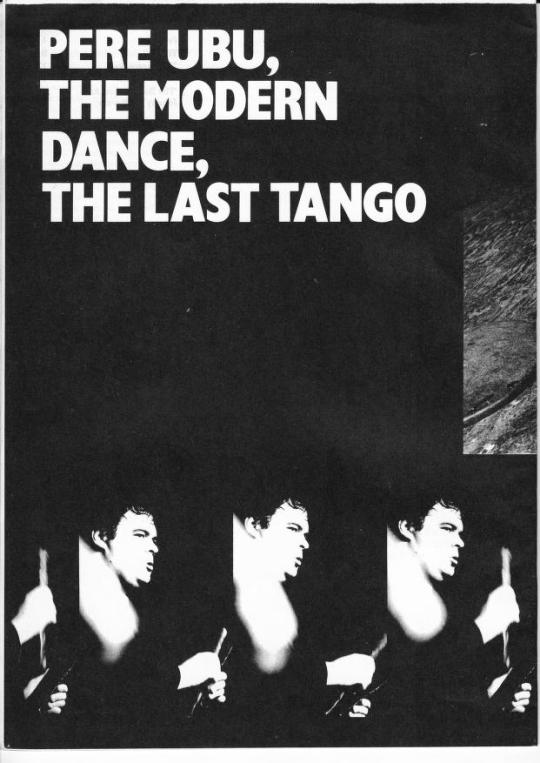
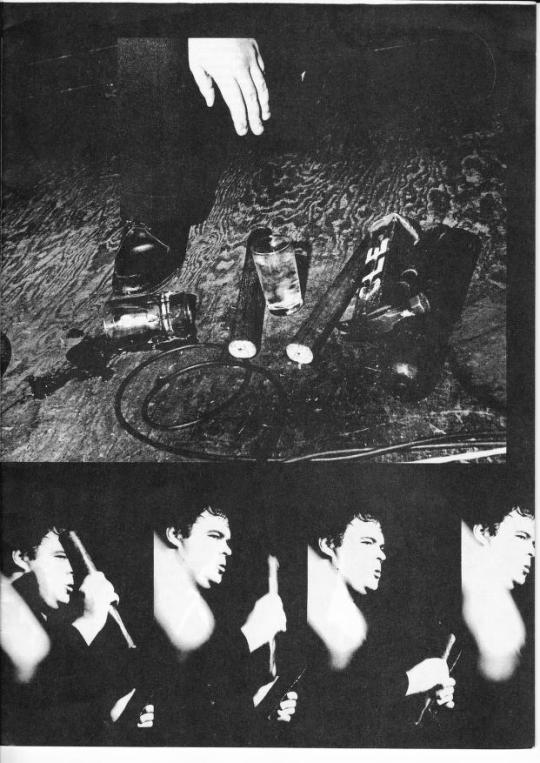
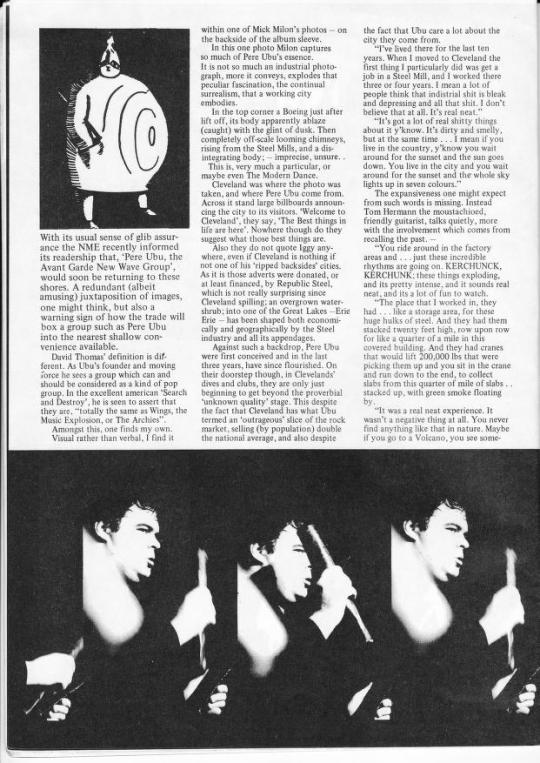
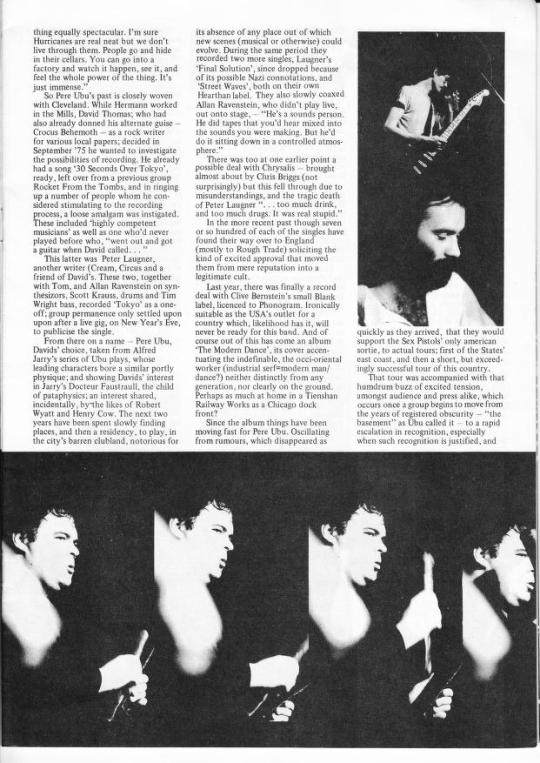
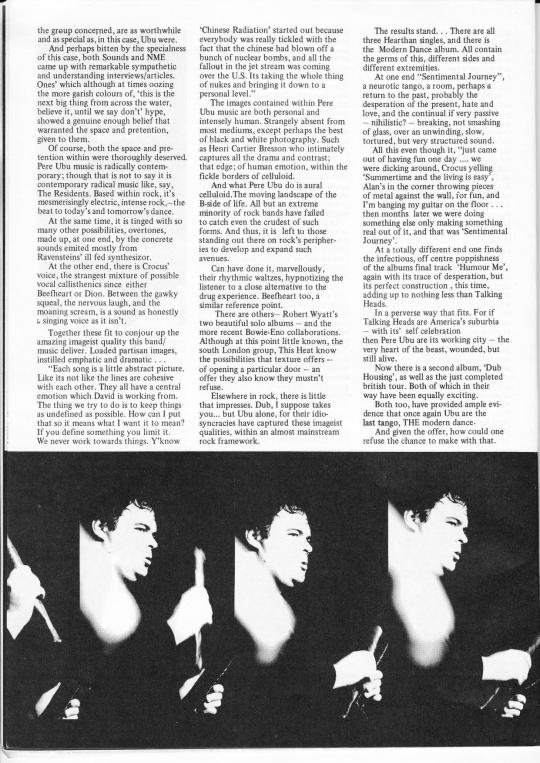
Dangerous Logic, n. 3, 1978.
29 notes
·
View notes
Video
youtube
Pere Ubu - We Have The Technology
13 notes
·
View notes
Text
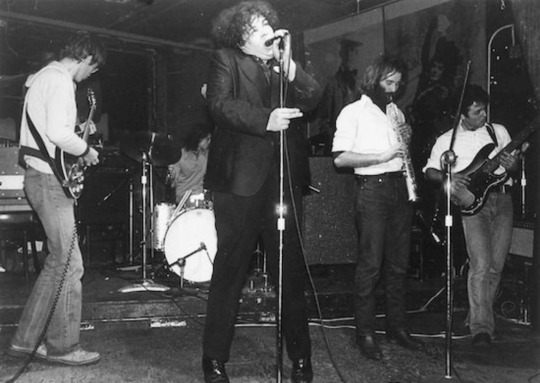
RIP Dave Thomas
12 notes
·
View notes
